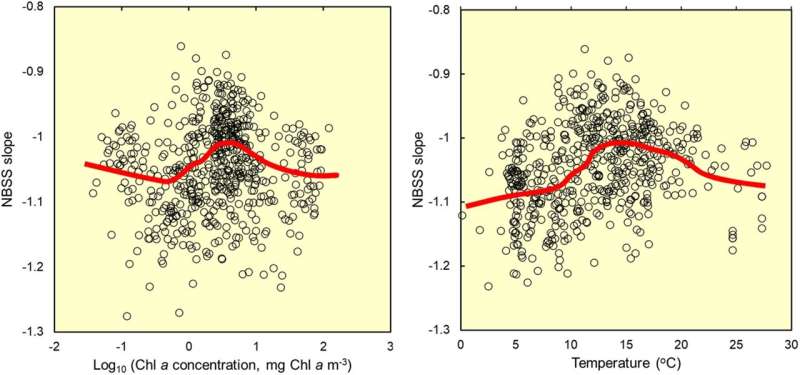This article has been reviewed according to Science X's editorial process and policies. Editors have highlighted the following attributes while ensuring the content's credibility:
fact-checked
peer-reviewed publication
trusted source
proofread
Climate change threatens fish supply: Tiny phytoplankton, big consequences

A research team that includes Dr. Angus Atkinson of the Plymouth Marine Laboratory and Dr. Axel Rossberg from Queen Mary University of London has discovered a hidden amplifying mechanism within the ocean's food web. Their findings, published in Nature Communications, reveal that when climate warming reduces phytoplankton levels by just 16%–26% (as projected by global models in regions like the North Atlantic), the carrying capacity for fish plummets by 38%–55%.
Global-scale computer models tend to agree that there will be a decline in phytoplankton in low and mid latitudes as the water warms and the surface layers become insulated from the supply of nutrients from below. In the North Atlantic, for example, plankton have already declined over the last 50 years. However, what happens further up the food web—up to the stocks of commercially exploited fish—is far from clear.
Some models suggest little change in fish and others project a major decline and importantly, the mechanisms vary greatly from model to model. These discrepancies show that we are still far from knowing how these food webs work.
The new study provides a fresh, independent, and relatively simple approach, based on field data rather than computer simulations. The team looked at the size structure of plankton directly. The relative abundance of small and large organisms provides a handy, direct measure of how efficiently the food web transmits energy from the smallest phytoplankton up to fish.
By compiling a large global database on marine and freshwater plankton size structure, the team were able to tease out the factors that dictated food web efficiency.
This amplification effect hinges on a surprising twist: Temperature, often blamed for food web disruptions, appears to play a secondary role. Instead, the key driver is the overall amount of phytoplankton, which governs how efficiently energy flows from tiny plankton to larger fish.
Warming oceans, the study reveals, impact fish indirectly, by reducing nutrient supply from deeper waters, ultimately shrinking phytoplankton size, and hindering energy transfer throughout the food web.
"Our global analysis sheds light on a hidden vulnerability," says Dr. Atkinson. "We were surprised to find temperature didn't directly affect food web efficiency. Instead, we see ecosystems adapting to warming by changing plankton size. This suggests the main threat comes from reduced nutrient supply, leading to smaller plankton, longer food chains, and inefficient foraging."
While this finding may seem counterintuitive, Dr. Rossberg explains the broader context. "Close to shore or in lakes, excess nutrients from land can cause imbalances like harmful algal blooms. But at the vast scales relevant to climate change, it's the lack of nutrients from deeper waters that becomes the major bottleneck."
The study underlines the urgency of factoring climate change into fisheries management. "Global averages can mask the true picture," explains Dr. Atkinson. "Some of the most significant projected declines are in areas with concentrated fishing activities."
This research calls for a multi-pronged approach to ensure sustainable fisheries in the face of climate change. "We need a combination of data on plankton size structure and sophisticated computer simulation models to design truly 'climate-smart' ocean protection strategies," concludes Dr. Rossberg. "By understanding the hidden amplifiers within the food web, we can better safeguard the future of our oceans and the vital resources they provide."
More information: Angus Atkinson et al, Steeper size spectra with decreasing phytoplankton biomass indicate strong trophic amplification and future fish declines, Nature Communications (2024). DOI: 10.1038/s41467-023-44406-5
Journal information: Nature Communications
Provided by Queen Mary, University of London

















